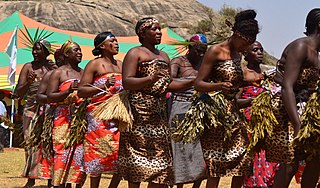
The Afroasiatic languages, also known as Hamito-Semitic or Semito-Hamitic, are a language family of about 400 languages spoken predominantly in West Asia, North Africa, the Horn of Africa, and parts of the Sahara and Sahel. Over 500 million people are native speakers of an Afroasiatic language, constituting the fourth-largest language family after Indo-European, Sino-Tibetan, and Niger–Congo. Most linguists divide the family into six branches: Berber, Chadic, Cushitic, Egyptian, Semitic, and Omotic. The vast majority of Afroasiatic languages are considered indigenous to the African continent, including all those not belonging to the Semitic branch.

The Omotic languages are a group of languages spoken in southwestern Ethiopia, in the Omo River region and southeastern Sudan in Blue Nile State. The Geʽez script is used to write some of the Omotic languages, the Latin script for some others. They are fairly agglutinative and have complex tonal systems. The languages have around 7.9 million speakers. The group is generally classified as belonging to the Afroasiatic language family, but this is disputed by some.
The Arabic word nisba may refer to:
African-Indian, usually refers to people of mixed Indian and African heritage.
Berber or Berbers may refer to:
The North Omotic (Nomotic) or Ta-Ne Omotic languages, are a group of languages spoken in Ethiopia. Glottolog considers Ta-Ne-Omotic to be an independent language family, whereas older classifications may link it to the Omotic branch of the Afro-Asiatic family, though this affiliation is disputed.

Ron is an Afro-Asiatic language cluster spoken in Plateau State, Nigeria. Dialects include Bokkos, Daffo-Mbar-Butura, Monguna/Manguna (Shagau),. Blench (2006) considers these to be separate languages.
The Dullay languages belong to the Cushitic subgroup of the Afro-Asiatic language family and are spoken in Ethiopia. Dullay is a dialect continuum consisting of the Gawwada and Tsamai languages. Blench (2006) places most of Bussa in the Konsoid languages, and counts several Gawwada varieties as distinct languages.

The Proto-Afroasiatic homeland is the hypothetical place where speakers of the Proto-Afroasiatic language lived in a single linguistic community, or complex of communities, before this original language dispersed geographically and divided into separate distinct languages. Afroasiatic languages are today mostly distributed in parts of Africa, and Western Asia.
Proto-Afro-Asiatic may refer to
This page is based on this
Wikipedia article Text is available under the
CC BY-SA 4.0 license; additional terms may apply.
Images, videos and audio are available under their respective licenses.


